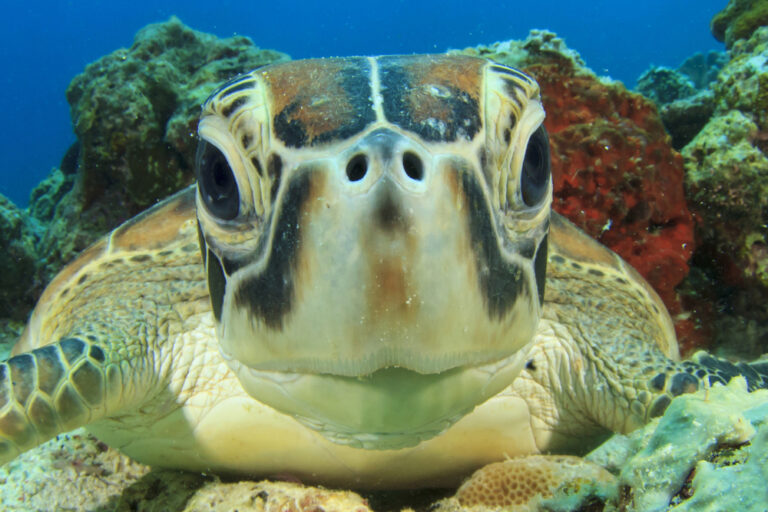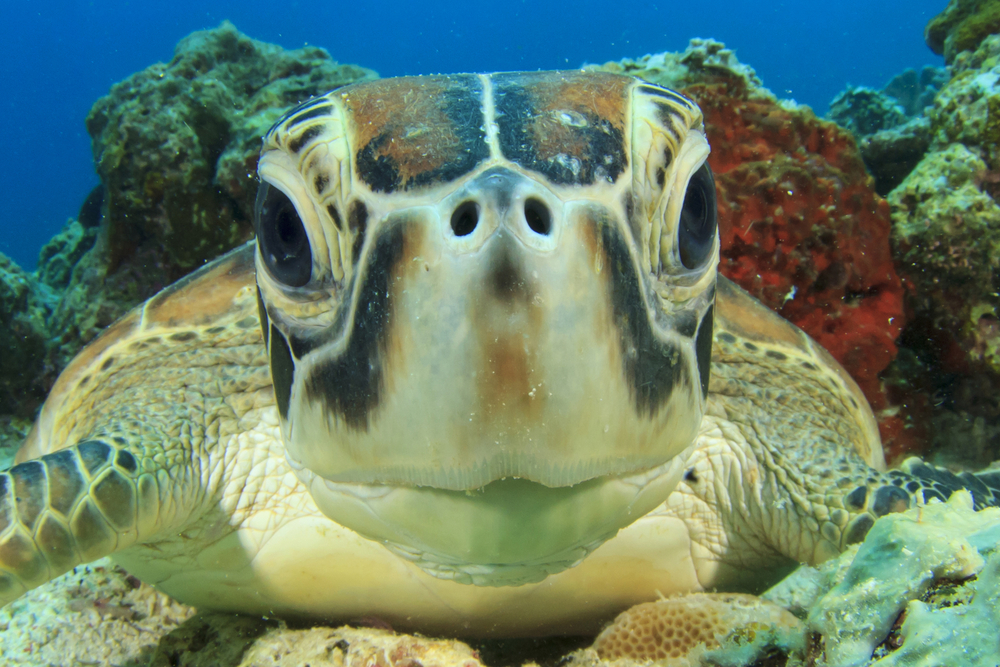
[ad_1]

Sea turtles are a staple to the ocean ecosystem. They can be found worldwide and play distinct roles in their environment. Sea turtles can live long lives and migrate great distances. They’ve even outlived the dinosaurs.
Unfortunately, however, as long as their lives may be, all seven sea turtle species are threatened or endangered. Between predation and human activity, sea turtles often find themselves in distressing situations. Here are why sea turtles are in danger and how you can help them, even from afar.
Types of Sea Turtles
In total, there are seven species of sea turtles, six of which are found in and around the coastal waters of the U.S. And, according to Melissa Cook, a research biologist for the National Oceanic and Atmospheric Administration (NOAA), all six species found in the U.S. are listed under the Endangered Species Act (ESA).
Sea turtles play an essential role in their ecosystem, says Cook. If the sea turtle population is unhealthy, it can indicate that the ecosystem is also faltering. Though all species have similarities, some of the biggest differences can be what the sea turtles eat and how far they migrate.
Green Sea Turtles
(Credit:Shane Myers Photography/Shutterstock)
According to Cook, green turtles are grazers. “They’re basically mowing the lawn and making sure we have healthy seagrass beds,” she says. Sea grass is a vital habitat for fish and invertebrates. When the turtles eat it down, it helps the beds become more productive.
Hawksbill Sea Turtles
(Credit:Andrei Armiagov/Shutterstock)
Hawksbill turtles, Cook says, live and thrive around coral reefs. Like loggerheads and ridleys, hawksbills are omnivores — meaning they eat plants and animals. While the hawksbill, in many areas, prefers eating sea sponges, it also eats marine algae, corals, mollusks, crustaceans and sea urchins.
They keep coral reefs healthy by balancing the sea sponge and urchin population and can crack through the sponges’ hard shells, leaving them for other marine animals to consume.
Leatherback Sea Turtles
(Credit:Agami Photo Agency/Shutterstock)
Leatherback turtles are named for their leathery shell versus the hard shells other sea turtles have. The largest of all sea turtles, they also migrate the most. They help make the ocean a bit safer by eating and mitigating the jellyfish population.
Kemp’s Ridley
(Credit:Prentiss Findlay/Shutterstock)
Named after Richard M. Kemp — the South Florida angler who discovered them — Kemp’s ridleys are the smallest species of sea turtle. Kemp’s ridley nest in what is called an arribada which means “arrival by sea” in Spanish. The females all gather in one place and head ashore to lay their eggs.
Olive Ridley
(Credit:Grethel Pavon/Shutterstock)
Olive Ridley turtles are named after their olive-green shells. They, too, exhibit arribada nesting behaviors and are considered omnivores. They live mostly in the open ocean. Like most sea turtles, the eggshells and unhatched eggs of Olive Ridleys help fertilize dune vegetation, Cook says. This, in turn, helps keep sand dunes and beach ecosystems stable.
Loggerhead Turtles
(Credit:Vladimir Wrangel/Shutterstock)
Loggerhead turtles have large heads and powerful jaws — which they use to crack the shells of clams and other mollusks. The remnants of their prey help provide nutrients for sea beds and sediment on the ocean floor. According to the World Wildlife Fund (WWF), small plant and animal colonies can live on a loggerhead’s shell.
Australian Flatback Turtle
(Credit:EA Given/Shutterstock)
Australian flatback turtles are only found in the waters of Australia and New Zealand, and sometimes Papua New Guinea. Named for its flat shell, the flatback turtle doesn’t migrate as far as other turtles and prefers shallower waters.
Are Sea Turtles Endangered?
According to Cook, while there has been an increase in the number of certain sea turtle species’ numbers, such as greens, loggerheads and Kemp’s ridleys, species such as Pacific leatherbacks are seeing a dramatic decline in numbers.
“Pacific leatherback sea turtles are genetically and biologically unique. They migrate extreme distances across the Pacific Ocean from nesting to foraging or feeding areas and are generally larger in size than Atlantic leatherbacks,” says Cook. “Pacific leatherback populations have plummeted in recent decades, declining by 80 to 90 percent throughout their range.”
The population decline is likely from extensive turtle and egg harvests for human consumption, loss of nesting beaches, along with bycatch in commercial fishing gear.
Read more: Sea Turtles Are Eating Plastic Because It Smells Like Their Food, Study Finds
Sea Turtle Predators
When it comes to predators for sea turtles, adult turtles only have to watch out for certain sharks — like the tiger shark. Most sea turtle predators go after hatchlings.
Once hatched, baby sea turtles must make the mad dash from their nest to the water. Along the way, predators such as seagulls, crabs and raccoons will snatch them off the beach. However, even in the water, hatchlings have to be quick. Fish and crabs can be waiting for the hatchlings to enter the waves.
Read more: Sea Turtles Use Shipwrecks as Artificial Reefs
How Do Humans Impact Sea Turtles?
The path from hatchling to adult is enough of a struggle with only natural predators to worry about. When you add the human element, sea turtle populations can plummet.
Plastic Waste
Plastic waste has become an increasingly alarming environmental issue with devastating consequences for marine life. Among the affected creatures, sea turtles stand out as particularly vulnerable to the harmful effects of plastic pollution. Sea turtles often consume single-use plastics or marine debris, which can lead to death.
Light Pollution
Human-caused light pollution near nesting beaches can also lead hatchlings astray when they emerge from nests. Baby turtles head toward the brightest thing they can see, which is often the ocean, and reflects the moon and starlight. Artificial light may confuse them, and they’ll follow the light away from the water, where they can easily become prey.
Climate Change
Warming sands due to climate change can impact the gender of sea turtles or prevent them from hatching at all. Lower sand temperatures usually produce males, while warmer temperatures produce females. If the sand temperature is too warm, there could be fewer males in the future.
Read more: Americans Rank First in Plastic Waste Contribution
What You Can Do To Help Sea Turtles
(Credit:kathayut kongmanee/Shutterstock)
Even if you don’t live near coastal areas, says Cook, you can find ways to help sea turtles. A great way to start is to reduce single-use plastics. All waterways can eventually find their way to the ocean, so reduce plastic use, even if you’re away from the coast. Use reusable water bottles, shopping bags and utensils. If you’re going to the beach, make sure to remove any trash you may bring and pick up any garbage you may see.
Think of alternative ways to celebrate loved ones other than a balloon release or firing off confetti cannons. It may be special to you, but those pieces of plastic could end up in the belly of a sea turtle. Other ways to help include donating your time or money to turtle-friendly organizations, such as sea turtle rescues, and educating yourself about their importance to the ecosystem.
NOAA and its partners are working diligently to prevent harm and help ensure a brighter future for all sea turtles so that they can perhaps continue living for millions of years more.
Read more: 5 Endangered Animals You Should Meet
[ad_2]